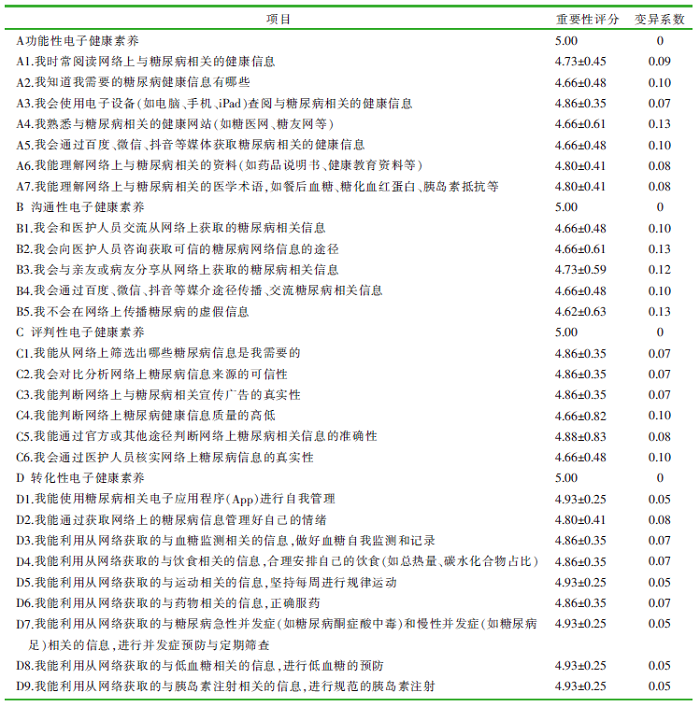| [1] |
Norman CD, Skinner HA. eHealth literacy:essential skills for consumer health in a networked world[J]. J Med Internet Res, 2006, 8(2):e9.
doi: 10.2196/jmir.8.2.e9
|
| [2] |
Park H, Cormier E, Gordon G, et al. Identifying health consumers’ eHealth literacy to decrease disparities in accessing eHealth information[J]. Comput Inform Nurs, 2016, 34(2):71-76;quiz99.
doi: 10.1097/CIN.0000000000000205
|
| [3] |
Hansen AH, Claudi T, Årsand E. Associations between the use of eHealth and out-of-hours services in people with type 1 diabetes:cross-sectional study[J]. J Med Internet Res, 2019, 21(3):e13465.
|
| [4] |
Wilson V. Patient use of the Internet for diabetes information[J]. Nurs Times, 2013, 109(23):18-20.
pmid: 23888634
|
| [5] |
Norman CD, Skinner HA. eHEALS:the eHealth literacy scale[J]. J Med Internet Res, 2006, 8(4):e27.
doi: 10.2196/jmir.8.4.e27
|
| [6] |
del Giudice P, Bravo G, Poletto M, et al. Correlation between eHealth literacy and health literacy using the eHealth literacy scale and real-life experiences in the health sector as a proxy measure of functional health literacy:cross-sectional web-based survey[J]. J Med Internet Res, 2018, 20(10):e281.
doi: 10.2196/jmir.9401
|
| [7] |
van der Vaart R, Drossaert CH, de Heus M, et al. Measuring actual eHealth literacy among patients with rheumatic diseases:a qualitative analysis of problems encountered using Health 1.0 and Health 2.0 applications[J]. J Med Internet Res, 2013, 15(2):e27.
doi: 10.2196/jmir.2428
|
| [8] |
Norman C. eHealth literacy 2.0:problems and opportunities with an evolving concept[J]. J Med Internet Res, 2011, 13(4):e125.
doi: 10.2196/jmir.2035
|
| [9] |
Paige SR, Stellefson M, Krieger JL, et al. Transactional eHealth literacy:developing and testing a multi-dimensional instrument[J]. J Health Commun, 2019, 24(10):737-748.
doi: 10.1080/10810730.2019.1666940
|
| [10] |
Silver MP. Patient perspectives on online health information and communication with doctors:a qualitative study of patients 50 years old and over[J]. J Med Internet Res, 2015, 17(1):e19.
doi: 10.2196/jmir.3588
|
| [11] |
Scantlebury A, Booth A, Hanley B. Experiences,practices and barriers to accessing health information:a qualitative study[J]. Int J Med Inform, 2017, 103:103-108.
doi: S1386-5056(17)30106-5
pmid: 28550995
|
| [12] |
崔念奇, 甘秀妮, 张传来, 等. 基于德尔菲法构建ICU患者身体约束评估量表[J]. 护理学杂志, 2018, 33(2):62-64.
|
|
Cui NQ, Gan XN, Zhang CL, et al. Construction of physical restraint assessment scale for ICU patients based on Delphi method[J]. J Nurs Sci, 2018, 33(2):62-64.
|
| [13] |
何芳, 郭晓琴, 王倩, 等. 基于德尔菲法构建女性盆底功能障碍高发人群一级预防自我护理能力量表[J]. 护理研究, 2021, 35(21):3906-3909.
|
|
He F, Guo XQ, Wang Q, et al. Construction of primary preventive self-care ability assessment scale for women with high incidence of pelvic floor dysfunction:a Delphi method[J]. Chin Nurs Res, 2021, 35(21):3906-3909.
|
| [14] |
Becker D, Grapendorf J, Greving H, et al. Perceived threat and Internet use predict intentions to get bowel cancer screening (colonoscopy):longitudinal questionnaire study[J]. J Med Internet Res, 2018, 20(2):e46.
doi: 10.2196/jmir.9144
|
| [15] |
徐子犊, 张帅, 耿季, 等. 糖尿病高危人群电子健康素养与健康促进生活方式的相关性分析[J]. 中华护理教育, 2020, 17(9):849-853.
|
|
Xu ZD, Zhang S, Geng J, et al. The association between eHealth literacy and health promoting lifestyle in high risk population of type 2 diabetes[J]. Chin J Nurs Educ, 2020, 17(9):849-853.
|


